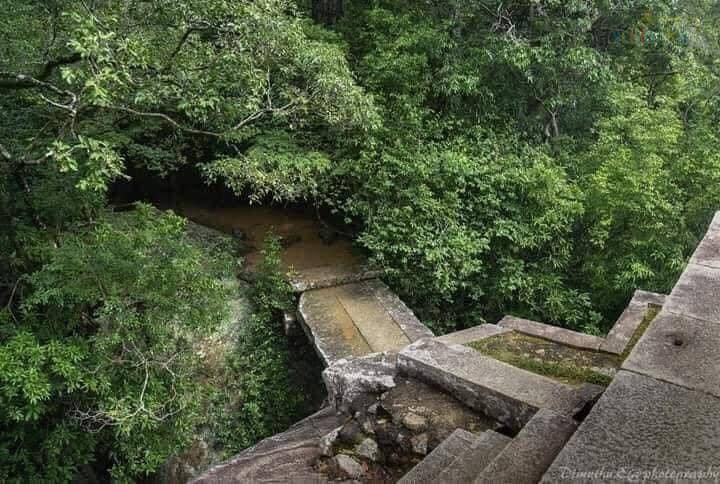
- Get directions
- Bookmark
- Share
- Leave a review
- Claim listing
- Report
- prev
- next
Description
Ritigala is a mountain range rooted in many mystical folk beliefs. Some people say that Ritigala was an area inhabited by Yaksha tribal people in the early days. It can be seen that among the pilgrims going to Anuradhapura, some are tempted to come to Ritigala to see its beauty. And foreign tourists also come to Ritigala. Because of this, you can see some hotels around here that provide them with food and accommodation.
How to get to Ritigala?
It is very easy to reach. On the Anuradhapura road running from Habarana through Maradankadawala. m. 15 should turn at the Galapitagala junction and take a side road. Distance from Colombo to Ritigala is km. m. There are about 201. From Maradankada, you can see the beautiful Ritigala mountain range on the horizon. It is a remarkable sight as there are no other mountains around here. When you turn from Galapitagala village and go a short distance, you will enter a concrete road that has fallen in the middle of the forest. Elephants travel on this road so you should avoid going early in the morning. The concrete road turns into Guru Road again. From there, the trail leads through a thick forest cover through the middle of Ritigala reserve. This road is well maintained so even a car can go easily. There is a parking lot at the foot of the hill. Distance from Galapitagala to the foothills. m. 8 If necessary, you can also get information from the archeology office located here.
Legends
This is how Ravana relates to Ritigala. As a response to Ravana's inadequacy, Sita, the queen of King Rama of India, was kidnapped and kept safe in Lankapura, and a war broke out with King Rama's brother Prince Lakshman who came to find her. Lakhs are injured in the war. Hanumanta, who came with him, went to the Himalayas in India to find medicine for the disease, but he forgot the name of the herb. After that, the area where the herbs are located is saved. According to a legend, a part of that mountain broke off and formed the medicine mountain that leads to Ritigala mountain.
History mentioned in Mahavamsa
A preserved bank bank of Banda Pond – Kusumsiri Wijaywardena
The monastery complex around this mountain range has a long history. In the Mahavamsa Ritigala is mentioned as Attagiri or Aritta Pabbata. King Suratissa (187-177 BC) built the Makulaka temple at the foot of this mountain. AD B.C. An inscription of the first century mentions the offering of a lake near the temple of Aritha. King Lajjatissa (119-110 BC) enlarged the Aritta temple and started the renovation. King Sena I (831-851 AD) was also a patron of this temple. It is also said that King Parakramabahu I organized a force to build forts around these mountains against the Manabharana of Ruhuna.
Recent history
During the British rule in 1872, James Mantle, a surveyor, stayed here for three months and did survey work. In 1890 Anuradhapura Disapati R. W. Ivers has built a home on a plain near the top of the mountain and has taken advantage of the cool climate here. Henry Tryman in 1887 studying the rhododendrons. Archaeological Commissioner H. C. P. Bell studies the Ritigala antiquities in 1883. After copying the inscriptions in the caves here, he combed the forest in search of the ruined buildings spread over the mountain. After that, all that information has been included in the 1883 Archeology Administration Report.
Why is Ritigala so special?
It is the highest mountain range in Kandy Kalavye with a height of 2514 feet (765 meters). Ritigala is the highest mountain between the central mountains of our country and the mountains of South India, so it is geologically special. Also, there is a forest with a cool climate where many plants grow in the wet zone even though it is located in the dry zone. Therefore, even in the dry season, you can often see how the ridges are covered in fog and hidden.
Because of this, the Ritigala forest has been made into a strict reserve as far back as 1931. The size of the strict reserve is 1528 hectares. In addition, 690 acres including the ruins of the monastery complex at the foot of the hill have been declared as an archaeological reserve.
The Ritigala mountain range has several other mountains. There are seven mountains belonging to it namely Dhoka Kanda, Kodigala Kanda, Una Kanda, Adiya Kanda, Fukutaka Kanda, Amarapati Kanda and Ulpat Kanda.
74 carved stone caves, 152 inscriptions written in Brahmi characters, ruins of about 140 different buildings with archaeological value, a large pond and a stone path can still be seen in Ritigala today. These ruins in the shade of large trees take us back to the past.
Wild ruins
When you climb the hill near the archeology office, you will first come across a large pond. It is called Banda Pokuna because it is bound with stones. This pond has been excavated recently and a part has been preserved. It used to get water from the water channels coming from the mountain. Even today you can see the water flowing on the road. From there, move forward and cross the pitagata and after crossing a stone bridge, you will enter a path that runs through the forest completely paved with black stones. The path is about one kilometer long.
After walking a short distance, you can reach the ruins. The Jantaghara building located there is a building for monks to take herbal and hot water baths. Medicinal millstones, stone jars, etc. can be seen there. There is a stone wall around the building. A stone basin in the form of a bathing pond has been prepared in the middle of the building. Before this we also met a Jantaghara in Arankele. Nearby, there are several double platform buildings called Padhanaghara where the monks used to live. It can be seen from the tiles found around that they had tiled roofs.
From here it is a wonderful experience to walk again along the path. You can walk listening to the sounds of wild animals and the rustling of trees. Many unpreserved Padhanagarhas can be seen under the forest. A three platform building (padhanaghara) is located on the plains that are found after a short distance. There is also a promenade built for meditation nearby.
Near this, the archaeological ruins end on the ground. After that begins the strictly reserved forest. Special permission must be obtained from the Forest Conservation Department to enter it.
Ritigala Biodiversity
In 1935, P. who studied plants here. D. R. Jayuriya discovered 27 species of orchids. Currently, the number of plant species found in this mountain range is 418. The number of flowering plant species is 338. The specialty is that among these 113 species are found in the wet zone. In a study done in 2008, it was revealed that 97 species of birds live here. Many species of mammals including elephant, bear, bull, tiger live here.
The lowest part of the ridge (land site) is characterized by dry mixed evergreen forests. In this area, you can see plants found in the dry region like Mora, Halmilla, Kaluvara, Veera, Palu, Na.
In the central region of the mountain range, the characteristics of wet zone forests are seen. Plants like Atamba, Kududaula, Omara, Kanda, Na are common in this area.
The nature of the sub-montane forests can be seen on the top of the hill. Plants like Nelu, Binara, Kekuna, Dum grow here.
Several plant species unique to Ritigala have also been found. Ritigala Tambajia, Gal Kappara Vallia, Ritigala Mee are among them.
Apart from this, rare medicinal plants such as Iraraja, Sandaraja, Vanaraja, Naga Maru Ala, Vellangiriya, Bim Kohomba, Jata Makuta are common here.
Sources-
Aritta Pabbata or Ritigala Mountain – Ellawala Medhananda Thero
Ritigala- Muditha Alahakon
The Fading Woods – Douglas B. Ranasingha
Don't forget to protect the environment
Location
-
Ritigala mountain, Sri Lanka
Categories
Views
You May Also Be Interested In
Kudumbigala Aranya Senasanaya
A Spiritual Oasis Amidst Nature's Splendor
- Kudumbigala Sanctuary
Dhanigala : Alien Mountain
Danigala Circular Rock - The Alien Mountain / Kandegama
- Danigala / Alien Mountain
Ruins of Ancient Kurundumale (Kurundavashoka) Viharaya in Mullaitivu
The only ancient Buddhist temple of its kind in Sri Lanka built fully out of Kabook
FA HIEN Caves - Pahiyangala - පාහියංගල
largest cave on the island, and one of the largest natural rock formations in all of Asia
- Fa-hienlena Prehistoric Cave
Dambulla Cave Temple 
Rangiri Dambulla Cave Temple
- Dambulla Cave Temple
































Add a review